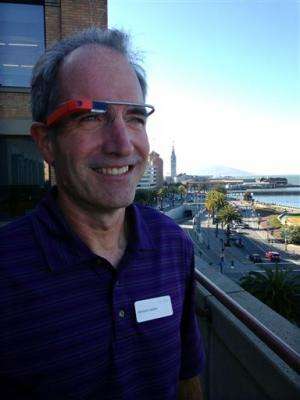Review: First peek through Google Glass impresses

Google hopes to change the face of technology by persuading people to wear computers on their heads.
That's the inspiration behind Google Glass, a spectacle-like device that contains a hidden computer, a thumbnail-size transparent display screen above the right eye and other digital wizardry. This Internet-connected headgear is set up to let users receive search results, read email, scan maps for directions and engage in video chats without reaching for a smartphone. Google Glass' grasp of voice commands even makes it possible to shoot hands-free photos and videos.
Google Inc. is touting Glass as a breakthrough that will make technology more convenient and less obnoxious in social situations. Critics call it a sign that technology is destroying personal privacy.
Only about 10,000 people in the U.S. have been given the chance to pay $1,500 to own a test version of Glass as part of Google's "Explorer" program. Last week, Google invited a few technology reporters and bloggers to test Glass under the company's supervision at a specially equipped San Francisco office that Google calls a "base camp."
I only got to spend about an hour wearing Glass. But I saw enough to conclude that it has potential to be much more than a novelty, especially if Google lowers the price below $500 by the time the company begins selling the device to the general public next year. The exact date has yet to be determined.
I also quickly realized that a lot of people will be turned off by Glass. It weighs about the same as a pair of regular sunglasses, but from what I've heard from people in the Explorer program, they are often greeted with quizzical looks from bystanders who see the tiny display screen above the right eye.
Turning on Glass is done by tapping a finger on the right side of the frame. The device can also be activated by tilting your head upward. Glass users have to turn on the device frequently; it automatically turned off every 30 seconds or so when I wasn't using it. This is meant to save the limited battery life. (It only lasts about 90 minutes if you're recording a lot of video, but Google says the battery should be adequate for a full day's use for most people.)
Navigating the Glass software requires swiping a finger on the right side of the frame.
Glass can connect to the Internet through a Wi-Fi network or by pairing with your smartphone through a Bluetooth connection.
Once online, it's easy to ask Google's search engine for a piece of information. An automated voice can give information through a bone conduction speaker near my right ear. When I asked Glass for directions to another location in San Francisco, it pulled up a map on the display screen and adjusted my course as I walked in different directions.
Even though the Glass screen is small, the display is in high-definition and gives the illusion that you are seeing the image on something much larger. Google likens it to watching a high-definition TV with a 25-inch (635-millimeter) screen from eight feet (2.4 meters) away.
Glass' coolest feature is its ability to almost instantly take photos with the device's 5-megapixel camera or record high-definition (720p) videos that provide a startling perspective on how your own eyes see things. This is done simply by saying "OK Glass, take a picture" or "OK Glass, record a video" and the device does it. The images can then be seen on the display screen and, then, with the right app, shared on Twitter or Facebook and stored on your Google Plus profile.
It's easy to see why the built-in camera on Glass is raising privacy concerns. The company has tried to minimize the chances of surreptitious photos or video being taken by ensuring a red light is visible whenever an image is being recorded.
Nevertheless, Glass has already been banned from gambling casinos, movie theaters and some bars to protect against cheating, copyright infringement and privacy intrusions.
© 2013 The Associated Press. All rights reserved.



















